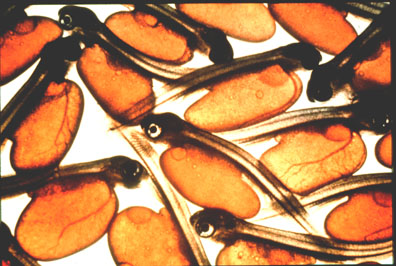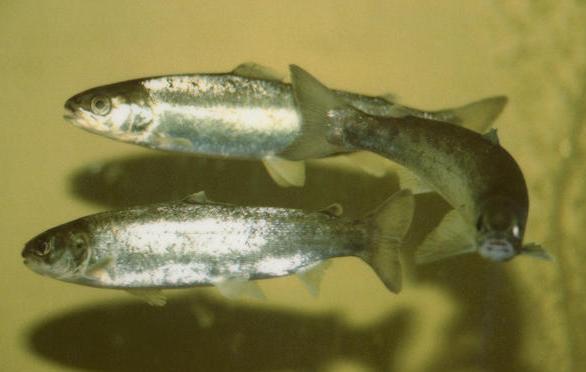The Circle of LIFE
 The life cycle of Salmo salar is
among the most unique life cycles in the world.
The life cycle of Salmo salar is
among the most unique life cycles in the world.
Try to imagine this: I was born in Alabama. We're going to call Alabama a large river. A soon as I was big enough to "swim" , I moved to Wisconsin. We're going to let Wisconsin be the ocean. The move there was pretty easy. Now that I'm grown up and able to reproduce, my hormones are telling me that I have to make the long trek back to Alabama to reproduce . The trip back isn't quite as easy though. Unfortunately, there are a lot of tolls (river dams and waterfalls) on the way back to Alabama. The tolls are a pain in the ass. They're really hard to get through and cost a ridiculous amount of money(energy). Besides, once I get to Alabama and pop out a few babies, I am probably going to die from exhaustion.
That doesn't sound very fun, does it? That is basically the life of a salmon. This life cycle is termed anadromous. The salmon are born in a river and swim to the ocean where there is plenty nutritious food to grow. Once they reach maturity, they return to almost the exact place where they were born, make several nests and lay their eggs. Atlantic Salmon, unlike many other species of salmon have the chance to reproduce more than once in their life times, but many die on the way back to the ocean after reproducing the first time. Reproduction expends an enormous amount of energy which makes the fish very fragile and unable to easily escape predators such as grizzly bears! Even if the salmon make it back to ocean, they are likely to be consumed by harbor seals, sharks or other larger fish.
Now that you have a general idea of what happens through an Atlantic Salmon life, let's get down to the nitty gritty details.
There are 6 stages of the salmon life cycle. This life cycle can span up to 15 years.
Eggs: The
eggs or ova are laid in nest, or redd, in late fall. The
nests are dug into the gravel of the riverbed and are between
four and 12 inches deep.
Little black eyes, a heart and other internal organs are visible
after about two weeks. It generally takes about three months for
the ova to hatch.
Alevin:
This is the first stage after the salmon have hatched from the
ova. During this stage, they live under the gravel and receive
nourishment from their yolk sacs.
Fry: At this stage, the salmon are learning to fend for themselves. They have absorbed their yolk sacs and are feeding on small insects and insect larva. Since they are so small, they are very susceptible to being consumed by larger fish and many birds. They spend most of their time hiding in the gravel and vegetation.
Parr: Salmon are
several months old at this stage. Distinctive markings are
visible along the sides of the parr. The markings are generally
dark, vertical stripes. Salmon stay at this stage for roughly
two years.

Smolt : The young salmon are finally ready to make the journey down the river to the ocean at this stage. They are silver in color and around a half a foot long. Once the smolt reach the ocean, they spend most of their time feeding. This is the stage at which majority of the growth occurs.
Adult: The salmon are finally mature! It is time for them to head back to the stream where they were born and lay eggs...or fertilize them in the case of the male salmon. Hormones, sense of smell and some visual clues lead the salmon back to its place of birth. The life cycle is complete!
The BIG, B-E-A-UTIFUL ADULT ATLANTIC SALMON!
Image Provided by
Gilbert van Ryckevorsel
This life cycles requires many
interactions with other organisms!
Questions?
Comments? Contact me at
webb.laur@students.uwlax.edu
Site Designed by Lauren Webb - Last Updated: 4.15.09
University of
Wisconsin - La Crosse
For
more interesting organisms visit
multiplerganisms.net
Back
to HOME

